Any type of mundane activity becomes a lot cooler when you do it in space. Shipbreaking is far from mundane, however, so taking it to space just supercharges the concept. I’m pleased to announce that Hardspace: Shipbreaker takes that concept and readily fulfills its premise.
In the future, life on Earth is bad. So bad, in fact, that people will sign up to be orbital shipbreakers for the Lynx Corporation. We’re talking full company-ruled living and indentured servitude treatment here. A shipbreaker incurs more than a billion space dollars in debt upon signing up. They have to repay the money via work, while also buying Lynx consumables vital for salvaging and survival. You also have to pay Lynx rent on habitat and tools, debt interest, cloning fees after death, and so on. You better hope you’re really good at space scrapyard tasks.
Zen and the Art of Mackerel Maintenance
Compelling story about workplace exploitation and the power of collective action aside, Hardspace: Shipbreaker is a first-person game about taking ships apart. You float in space with the regular FPS controls and use your limited set of tools — as well as ingenuity — to break derelicts down to pieces before sorting them to gain credit.
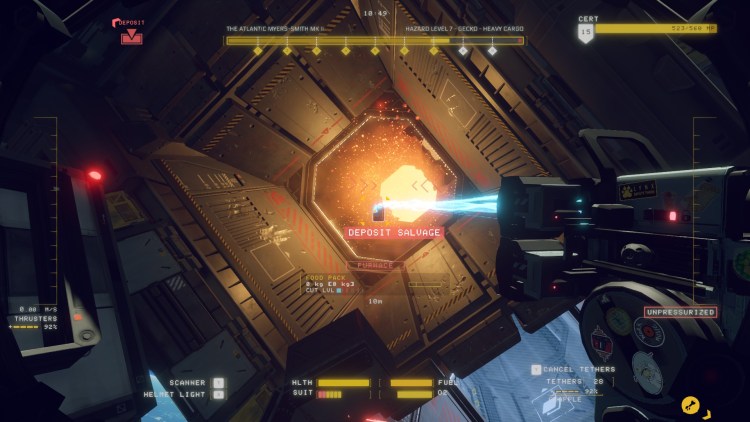
Using a handheld implement operating on poorly understood physics to chuck a bag of chips into a giant incinerator. IN SPACE!
Lynx uses all parts of the buffalo, so every ship piece goes into some sort of receptacle. You yeet aluminum structures into the furnace, chuck nanocarbon and similarly fancy materials into the processor, and any devices go into the barge for reuse. Put the right thing into the right hole, and you’ll make money. Mess up, and you’ll pay Lynx a fine. Either way, the company wins.
The main tools in Hardspace: Shipbreaker are the Cutter and the Grappler, but it’s not as simple as that. There are a lot of materials the Cutter can’t cut, so you’ll have to find cut points with your scanner and detach them that way. On the other hand, not everything breaks down non-destructively, and some items (especially electronics and gas tanks) react violently to high-powered lasers. You’ll also run into objects too heavy to move with the Grappler or its consumable tethers, making it impossible to easily chuck half a patrol boat, for example, into the processor.
There’s always something
Those are just early issues you’ll have to overcome with every ship. As you cut apart stellar vessels and gain in rank, the derelicts you get will increase in complexity. Oops, this one has pressurized compartments. Better get in and and depressurize them with the atmosphere controller or you’ll incur explosive decompression while cutting th- wait, the controller is busted? Now what do you do?!
Oh no, the explosive decompression has ruptured the gas tanks and blown up the very expensive reactor, and now all those tidy panels are a cloud of debris rapidly leaving the play area! The possibilities build.
At the same time, you have 15 minutes per shift to take apart as much junk as you can but with a lot less oxygen. Sure, you can sometimes scavenge or find other consumables on the ships themselves, but you can’t rely on that. In any case, time pressures exist to make you perform faster.
Getting good as a core part of the gameplay experience
All in all, there’s a genuine sense of achievement in Hardspace: Shipbreaker when you learn to take a ship apart really fast. While the game randomizes the placement of some internal components, a few of of the larger structures and their cut points remain the same between ships of the same class.
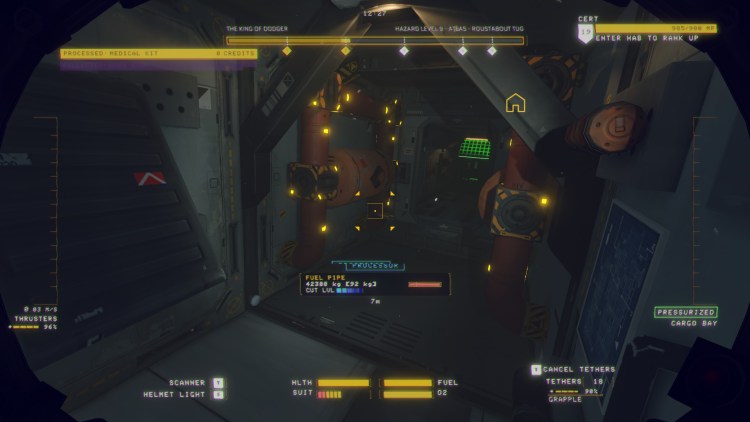
The screen distortion tells me that there’s a reactor nearby. Best not to think what that meant to the unshielded former crew of the ship.
As for for the rest… Well, you’ll feel awfully smug after safely depressurizing the insides of a ship. You feel good with every Class II reactor successfully salvaged, and there’s always some pride in watching the last aluminum internals from the ship float into the furnace at the end of a job. Granted, you don’t have to finish every ship, and the progression rewards top out at around 90%. But every bit salvaged is money!
But, while money is necessary for your progression and topping off consumables, you really need those Lynx tokens that come from beating salvage thresholds to improve your gear. Unfortunately, the upgrades in Hardspace: Shipbreaker are really boring, as they only increase capability and never really feel transformative. On the other hand, a refill of tethers is $18K no matter the capacity, so having the space for 40 is a lot more economical than 20.
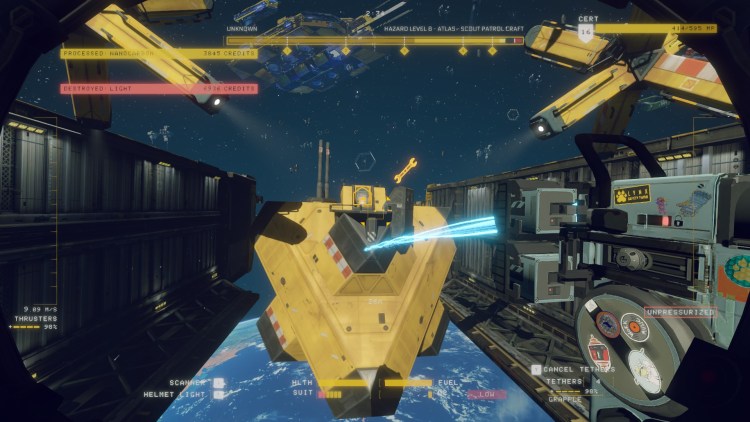
No joke, the easiest increase in capability to notice is Grappler range because it means you can eventually pull yourself up to the kiosk from the other side of the salvage bay.
Plus, things like damage resistances and suit HP increases definitely helped me get through the main campaign with only one death (I’ve had plenty of near-death brushes due to explosive decompression and such).
All work and no play?
All in all, it took me 30 hours to beat Hardspace: Shipbreaker, though you don’t have to stop there. Free play is available for those who want to relax. And for those who don’t, there’s the Cutter Race, where everyone’s given the same ship and salvage goal. There’s also a global scoreboard tracking the campaign career stats. It’s sorted by campaign difficulty: standard means having shifts, but no respawn limit, and the hardest difficulty only gives you one life.
Though, frankly, I can’t see myself playing Hardspace: Shipbreaker that long. The habitat segments run out of steam long before that point. At first, you’re besotted with emails and conversations with other characters. But those run dry, and waking up for a new shift means hearing one of the five wakeup routines the AI plays. Sure, you can collect data discs on ships to learn more lore, but that requires them to spawn in the first place.
And if you receive a call in the habitat, half of the time you can’t even do anything for the duration. It gets grating, especially for someone as fidgety as I am.
The second reason is that by the time you end the campaign, you’ve probably already taken apart every type of ship there is. There are, roughly speaking, four classes of ship with various subclasses that change the equipment (and danger) you’ll encounter. Once you’ve taken them apart a couple of times, no amount of randomization will help. And internal components can only increase so much. With a Class I reactor, you need to put it into the barge as fast as possible after taking it out. Class II demands you fiddle around with some other systems and dismantle its casing before you can toss it. There is no Class III.
Space (work) is beautiful
All that aside, Hardspace: Shipbreaker is a good-looking game. The ship designs — flat, angular, and brightly colored — harken to sci-fi book covers and Chris Foss’ art rather than the overdetailed designs popular today. It’s very Homeworld, which is unsurprising, considering the studio developing this game wanted to make Hardware: Shipbreakers, which turned into Homeworld: Deserts of Kharak.
Hardspace: Shipbreaker is good game. It’s surprisingly fitting for quick, short plays. The 15-minute shifts are just enough to get in, get something done, and get out. At the same time, as the game reaches its 1.0 release, it’s finally poised to receive DLC that can expand the ship roster and introduce more complex systems to work with. At least, that’s the hope.

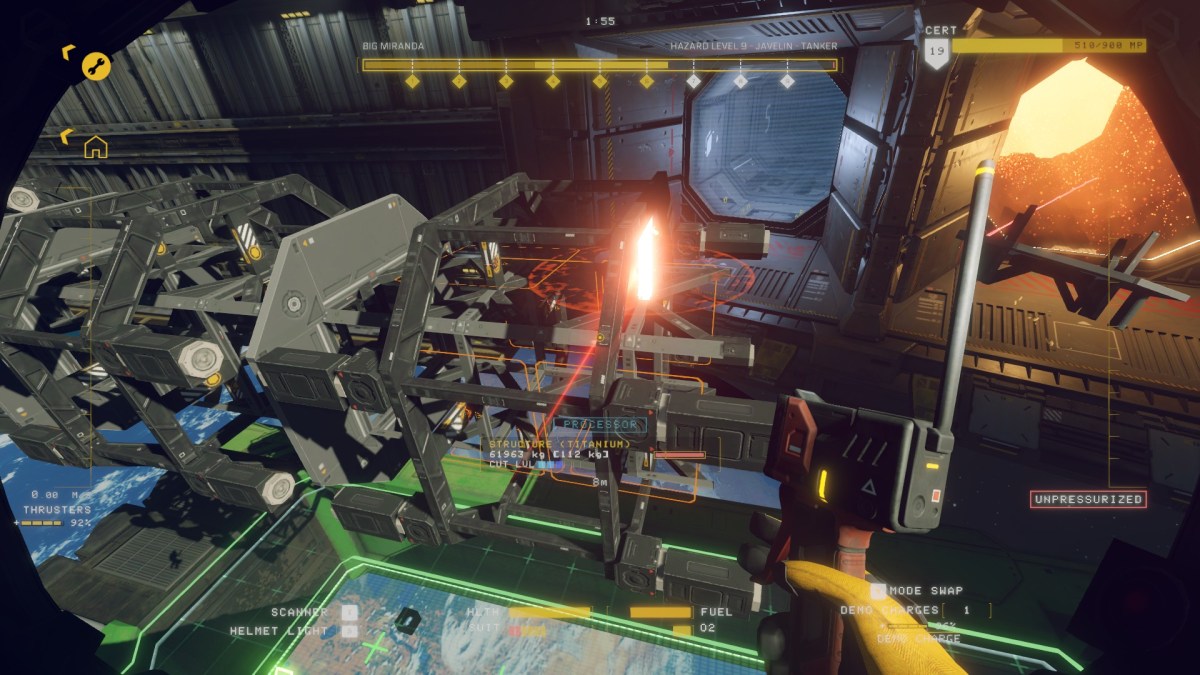

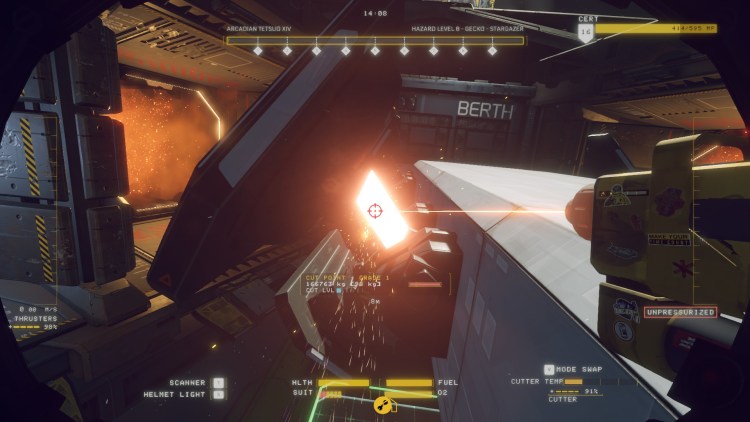
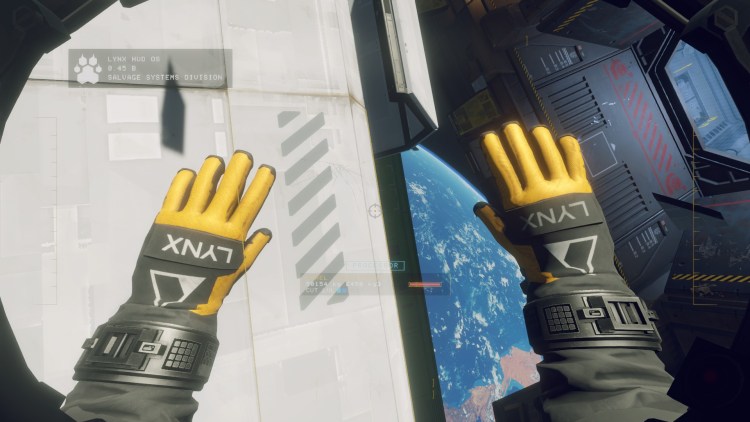






Published: May 24, 2022 12:00 pm